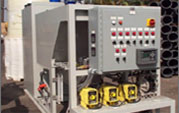BOD Reduction
Treatment of Wastewater
In commercial, industrial, and municipal settings, dealing with wastewater can be a challenge. Wastewater from these facilities can contain various compounds. According to environmental regulations, these need to be removed using a wastewater treatment system before the water can be reused or released back into the environment.
At Complete Water Services, we provide a range of wastewater treatment systems for these demanding and stressful environments. Our systems are designed to be reliable and efficient, making them suitable for a broad range of wastewater applications.
Specialized Onsite Wastewater Treatment Systems
Complete Water Services specializes in OWTS or onsite wastewater treatment systems. These are designed and developed by hands-on professional designers and engineers dedicated to solving wastewater issues. Our systems feature advanced technology, allowing them to be tailored to the needs of each customer.
We use a variety of chemical treatment programs that can be incorporated into an onsite wastewater treatment system to treat contaminated wastewater effectively. However, treatment options vary depending on the type of wastewater. We can also provide custom designs for specific requirements or environments.
Some of our Water Treatment Chemical Programs include:
- Odor control chemicals
- Foam control chemicals
- Membrane system treatment
- Polymer flocculants & coagulants
- Biodispersants and biocides
We can find a unique solution to your wastewater challenges, whether industrial, commercial, or municipal wastewater streams. Our team of experts consisting of Civil, Mechanical, Chemical, Process, and Environmental Engineers will determine the right solution to your wastewater treatment needs.
Treatment of Water Pollution from Industrial Facilities
Wastewater varies from one industry to another; however, there are different types of pollutants that are present in industrial wastewater. By treating them properly with a custom industrial wastewater treatment system, we can ensure that the effluent quality will meet regulatory limits.
Before designing a wastewater treatment system, experts will base the design on a set of factors, including:
- Characteristics of the contaminants
- Understanding the flow and contamination levels that occur daily
- The categorical and/or discharge limits imposed by the regulatory agency
Once necessary information has been gathered, the design is developed and modified to fit your industrial facility’s requirements. The design will factor in the type of treatment method, its effectiveness, cost efficiency, and more.
Solving Wastewater Generated by Your Community
On a much larger or municipal scale, a municipal wastewater treatment system can be used to process wastewater from an entire community.
We develop an economical design that effectively treats wastewater while protecting public health and the environment.
Let Us Deliver & Fulfill Your Wastewater Treatment Needs
Complete Water Services is your go-to partner if you’re searching for an optimal and reliable onsite wastewater treatment system. We ensure that these cost-effective solutions meet and exceed our customers’ expectations.
If you want to know more, please feel free to contact us today. We can help you find suitable treatment options for your wastewater streams.


